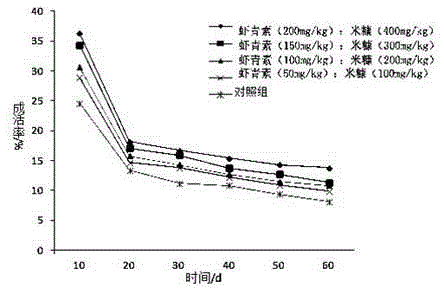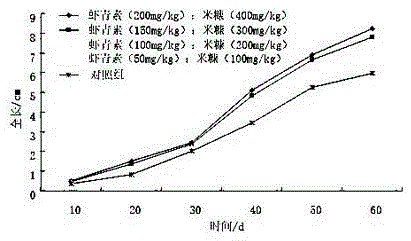Bait additive capable of increasing raised fry survival rate of epinephelus and use method thereof
An additive and a technology for grouper, which is applied in the field of bait additives for improving the survival rate of grouper seedlings, can solve the problems of hindering the industrial development of grouper breeding, the harm of aquatic animals, and the less application of astaxanthin, and reduce the Nerve necrosis virus, improve the survival rate of culture, the effect of natural origin
- Summary
- Abstract
- Description
- Claims
- Application Information
AI Technical Summary
Problems solved by technology
Method used
Image
Examples
Embodiment 1
[0017] (1) Preparation of bait additives: take Haematococcus pluvialis, transform it from green vegetative sporophyte into red sclerenchyma sporophyte rich in astaxanthin after being stressed, filter and dry, then grind into powder. Natural astaxanthin is prepared by mixing natural astaxanthin and rice bran at a ratio of 1:2. The content of natural astaxanthin can be 50mg / kg, 100mg / kg, 150mg / kg or 200mg / kg .
[0018] (2) Biological bait preparation: add the bait additive prepared in step (1) to the biological bait, and the 3-day-old biological bait, 6-day-old biological bait, 9-day-old biological bait, and 12-day-old biological bait are fertilized oysters respectively Eggs, rotifers, Artemia, and copepods, the above-mentioned biological bait was wrapped and fed with 100mL / kg fish oil. During this period, each experimental group was set up in three parallels, and a control group was set up. The control group was without any additives. Copepod bait.
[0019] (3) Feeding manage...
Embodiment 2
[0021] (1) Preparation of bait additives: take Haematococcus pluvialis, transform it from green vegetative sporophyte into red sclerenchyma sporophyte rich in astaxanthin after being stressed, filter and dry, then grind into powder. Natural astaxanthin is prepared by mixing natural astaxanthin and rice bran at a ratio of 1:2. The content of natural astaxanthin can be 50mg / kg, 100mg / kg, 150mg / kg or 200mg / kg .
[0022] (2) Preparation of soft pellet feed: add the bait additive prepared in step (1) into the soft pellet feed. During this period, three parallels were set up for each experimental group, and a control group was set up. The control group was soft pellet feed without any additives.
[0023] (3) Feeding management: During the experiment, the water temperature was maintained at 23.2-24.8°C, the salinity was maintained at 26.35, and the pH was maintained at 7.98-8.03, and the residual bait, feces, and dirt on the surface were removed every day, and observations were made....
PUM
 Login to View More
Login to View More Abstract
Description
Claims
Application Information
 Login to View More
Login to View More - R&D
- Intellectual Property
- Life Sciences
- Materials
- Tech Scout
- Unparalleled Data Quality
- Higher Quality Content
- 60% Fewer Hallucinations
Browse by: Latest US Patents, China's latest patents, Technical Efficacy Thesaurus, Application Domain, Technology Topic, Popular Technical Reports.
© 2025 PatSnap. All rights reserved.Legal|Privacy policy|Modern Slavery Act Transparency Statement|Sitemap|About US| Contact US: help@patsnap.com



